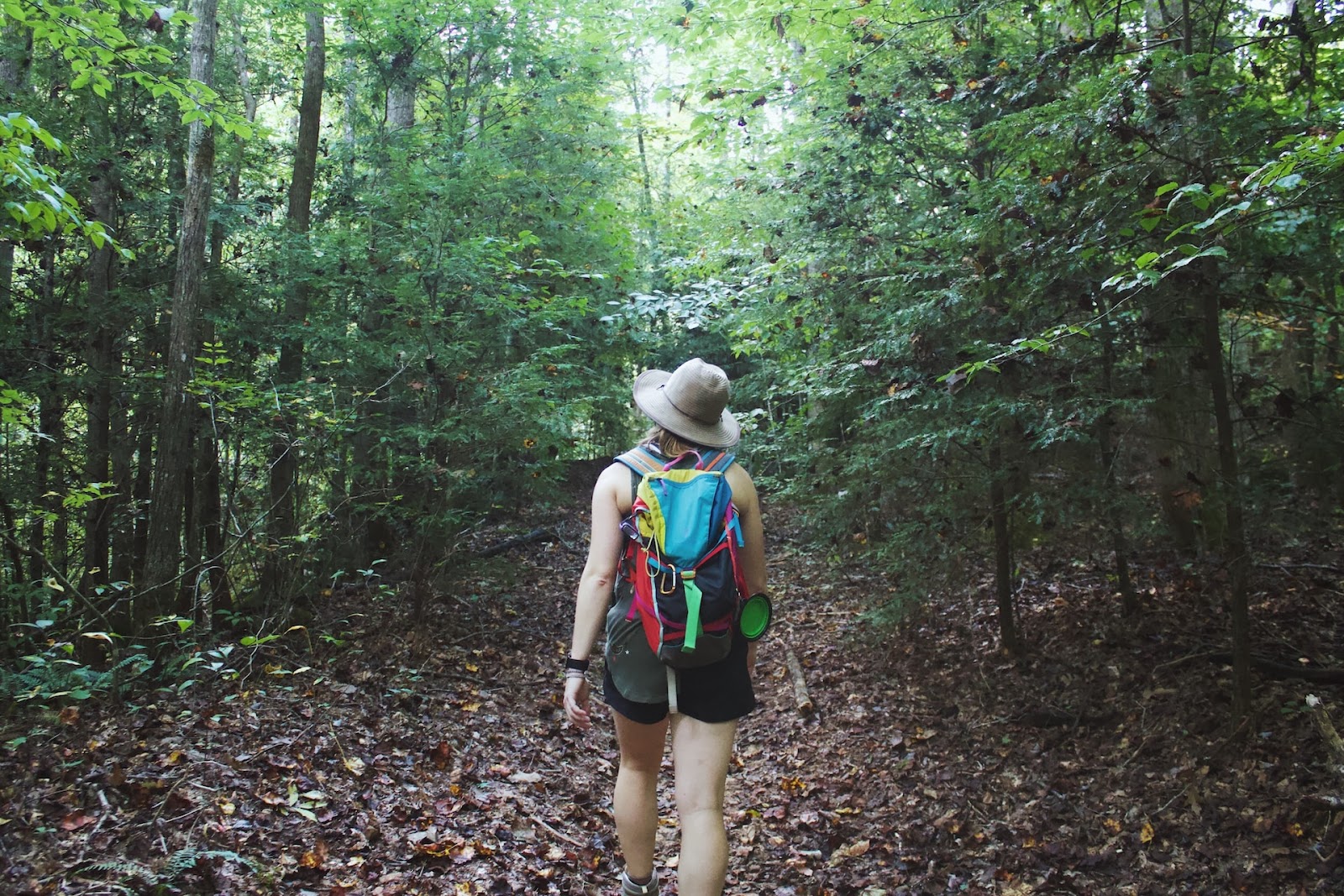When it comes to summer hiking, choosing the right fabric can make all the difference in your comfort and performance. Here are some of the best fabrics for summer hiking:
| Nylon | This fabric is lightweight, durable, and quick-drying, making it perfect for hot and humid conditions. Additionally, nylon is resistant to tears and abrasions, which can come in handy on rugged terrain. |
| Polyester | Polyester is another great option for summer hiking; it is moisture-wicking, breathable, and fast-drying. It also resists wrinkles, shrinking, and fading, making it ideal for extended trips. |
| Merino Wool | While wool may not seem ideal for summer hiking, merino wool is different. This type of wool is lightweight, breathable, and moisture-wicking, making it perfect for hot weather. Additionally, it is odor-resistant and antimicrobial, making it a great choice for multi-day trips. |
| Bamboo | Bamboo fabric is soft, lightweight, and breathable, making it comfortable for extended wear. Additionally, it is moisture-wicking and fast-drying, making it ideal for sweaty hikes. |
What to Wear Hiking in Summer
When it comes to summer hiking, you must choose the right fabrics and clothing to ensure maximum comfort and protection. There are several fabrics and materials available on the market that can reduce the possibility of overheating and discomfort while out on the trails.
In this article, we will discuss the best fabrics for summer hiking and how they can help you stay cool and comfortable during your outdoor adventures.
Why Choosing The Right Fabric For Summer Hiking is Important
Choosing the right fabric for summer hiking is crucial as it can make or break your experience on the trails. The best materials for summer hiking are lightweight, breathable, moisture-wicking, quick-drying, and provide protection against the sun’s harmful rays.
Here’s a list of some of the best fabrics for summer hiking:
| Fabric | Properties |
| Nylon | Lightweight, durable, quick-drying, provides excellent protection against the sun and wind, abrasion-resistant |
| Polyester | Breathable, moisture-wicking, quick-drying, provides UV protection |
| Merino Wool | Natural and sustainable, provides insulation, breathability, and moisture-wicking properties, odor-resistant, regulates body temperature |
So, when gearing up for summer hiking, make sure to choose the right fabric to ensure a comfortable and enjoyable hiking experience.
Types of Fabrics For Summer Hiking
Choosing the right fabric for summer hiking is essential for a comfortable and successful outdoor trip. There are a variety of materials to choose from, each with its own unique benefits, so selecting the right type of fabric can make a huge difference.
In this article, we will look at the various fabric options that are available and discuss their pros and cons for summer hiking.
Lightweight And Breathable Fabrics
Choosing the right fabric for summer hiking is crucial to stay comfortable and cool on your trek. Opting for lightweight and breathable fabrics can make a significant difference in your hiking experience.
Here are the best fabrics for summer hiking:
| Fabric | Description |
| Nylon | Durable and lightweight, nylon is perfect for hot weather as it wicks away moisture and dries quickly. Nylon is a popular choice for hiking pants, shorts, and windbreakers. |
| Polyester | This fabric has excellent moisture-wicking properties and is highly breathable. It’s perfect for hiking shirts and base layers that sit close to the skin. |
| Merino wool | Merino wool is a natural fiber known for its excellent breathability, moisture-wicking, and odor-resistant properties. It’s best suited for hiking socks, base layers, and T-shirts. |
| Bamboo | Bamboo fabric is a sustainable and eco-friendly option for hikers. It’s lightweight, soft, and has excellent moisture-wicking properties. |
Choosing lightweight and breathable fabrics for summer hiking will allow you to stay cool, dry, and comfortable throughout your trek.
Moisture-wicking Fabrics
Moisture-wicking fabrics are the best option for summer hiking as they help to regulate body temperature and keep you dry and comfortable throughout your activity.
Here are some of the best moisture-wicking fabrics for summer hiking:
| Polyester | This is the most common fabric used for moisture-wicking clothing. It is lightweight, breathable, and dries quickly. |
| Nylon | Nylon is also a popular choice for hiking clothing, as it is lightweight, durable, and moisture-wicking. |
| Merino wool | Although wool may not be the first choice for summer hiking, merino wool is an exception. It is lightweight, breathable, and naturally moisture-wicking, making it ideal for hot weather. |
| Bamboo | Bamboo fabrics have natural moisture-wicking properties and are also lightweight and breathable. |
These fabrics are designed to wick sweat away from your body and allow it to evaporate quickly, which helps to regulate your body temperature and prevent overheating. Additionally, they reduce the risk of chafing and blisters caused by wet clothing.
Sun-Protective Fabrics
When it comes to summer hiking, choosing the right fabric for your clothing is crucial to ensure comfort and protection from harmful UV rays. Here are some of the best fabric options for summer hiking:
| Nylon: | This lightweight and durable fabric dries quickly and is perfect for hot and humid weather. It also provides good protection against the sun’s harmful UV rays. |
| Polyester: | This synthetic fabric is lightweight, breathable, and moisture-wicking, making it an ideal choice for summer hikes. It also offers excellent protection against UV rays. |
| Merino Wool: | This natural fabric is soft, moisture-wicking, and has natural UV protection properties that make it perfect for sun-filled hikes. It also regulates body temperature, keeping you cool and comfortable. |
| Bamboo: | This eco-friendly and sustainable fabric is soft, breathable, and dries quickly. It’s also naturally UV-resistant and great for sensitive skin as it’s hypoallergenic. |
When selecting fabric for your summer hiking clothes, consider its breathability, moisture-wicking capabilities, and UV protection properties to ensure maximum comfort and protection.

Features to Look For in Summer Hiking Fabrics
When choosing the best fabrics for summer hiking, there are a few things to consider. You will want materials that are lightweight yet durable, breathable, moisture-wicking, and fast drying. In this article, we will discuss the features to look for in summer hiking fabrics, so you can make the most informed decision when selecting the best fabric for your outdoor adventures.
Quick-Drying Ability
The quick-drying ability of fabrics is an essential feature to look for in summer hiking clothes. Wearing clothes that dry quickly helps in maintaining the body temperature, keeping moisture away from the skin, and avoiding chills and hypothermia in cold weather conditions.
Here are some fabrics with the excellent quick-drying ability to consider for your next summer hiking trip:
| Fabric | Properties |
| Polyester | Durable, lightweight, breathable, and has excellent moisture-wicking properties. |
| Nylon | Lightweight, quick-drying, and abrasion-resistant. |
| Merino wool | Moisture-wicking, quick-drying, and odor-resistant. |
Quick-drying fabrics not only help in maintaining hygiene and body temperature during prolonged physical activities but also provide comfort and long-lasting durability to withstand outdoor conditions.
Abrasion Resistance
Abrasion resistance is a key feature to look for in fabrics when choosing gear for summer hiking. A good quality summer hiking fabric must be able to withstand the rigors of harsh outdoor conditions such as rough terrains, rock surfaces, and snagging tree branches.
Fabrics that exhibit superior abrasion resistance include:
| Fabric | Description |
| Cordura Nylon | This is a versatile, durable, and rugged fabric that is resistant to abrasion and tearing. It is ideal for making backpacks, luggage, and high-performance tents. |
| Ripstop Nylon | This is a lightweight, ultra-durable fabric that is resistant to ripping and tearing. It is perfect for making high-quality outdoor gear such as backpacks, tents, and tarps. |
| Kevlar | This is a high-performance synthetic fiber that is extremely strong and has exceptional resistance to abrasion and impact. It is widely used in making hiking boots, gloves, and body armor. |
Other fabrics that exhibit high abrasion resistance include Polyester, Nylon, and Neoprene, among others. When selecting summer hiking fabrics, prioritize abrasion resistance for optimal durability and performance.
Odor Control
Odor control is an important factor to consider when choosing the best fabrics for summer hiking. Synthetic fabrics such as polyester, nylon, and spandex often have anti-odor properties that make them ideal for outdoor activities. Natural fabrics like cotton and linen, on the other hand, tend to retain odor and may not be the best choice for extended hikes in hot weather.
When looking for summer hiking fabrics, consider the following features:
| – Moisture-wicking properties to keep you dry and comfortable. |
| – Breathability for better airflow and ventilation. |
| – Lightweight and quick-drying for easy packing and convenience. |
| – Anti-odor technology to prevent the buildup of bacteria and sweat. |
| – UPF sun protection to shield your skin from harmful UV rays. |
By choosing fabrics with these features, you can ensure a comfortable and pleasant hiking experience even in the hottest summer months.

Considerations When Choosing Fabrics For Summer Hiking
When choosing fabrics for summer hiking, there are several factors to consider. These include things like breathability, comfort, and durability. Not all materials are created equal when it comes to these features, so it is important to research which fabrics will best suit your needs when choosing the best fabrics for summer hiking.
This article will discuss some of the main considerations when selecting fabrics for summer hiking, to help you make an informed decision.
The Terrain
When choosing fabrics for summer hiking, it’s essential to consider the terrain you’ll be trekking on. The best fabrics for summer hiking should be versatile enough to accommodate different terrains while keeping you comfortable and well-ventilated.
Here are the best fabrics that cater to varying terrains:
| Fabric | Terrain | Benefits |
| Cotton | Flat terrains with low elevations | Lightweight and breathable |
| Nylon | Rocky terrains or trails with water crossings | Durable and lightweight; protects against sun’s harmful rays |
| Polyester | Humid weather and strenuous hikes | Moisture-wicking; dries quickly |
| Merino Wool | Hiking in the mountains, especially in cold weather | Temperature-regulating; wicks moisture well; prevents body odor |
Choose the right fabric based on the terrain you’ll be hiking on to ensure optimal comfort, performance, and protection.
The Weather
When it comes to summer hiking, choosing the right fabric can make all the difference in staying comfortable and safe. The best fabrics for summer hiking are those that are breathable, moisture-wicking, quick-drying, and offer sun protection.
Here are some fabric options to consider:
| Fabric | Properties |
| Nylon | Lightweight, durable, dries quickly, offers excellent sun protection, resistant to tears and abrasions. |
| Polyester | Moisture-wicking, quick-drying, lightweight, offers good sun protection, and is resistant to wrinkles and shrinking. |
| Merino wool | Natural fiber, moisture-wicking, quick-drying, offers excellent odor control, lightweight, and good sun protection. |
Pro tip: Avoid cotton fabrics for summer hiking as they absorb moisture, dry slowly and can make you feel uncomfortable and prone to chaffing.
Personal Preferences
When choosing fabrics for summer hiking, personal preferences play a significant role in determining which fabric to use. However, there are some considerations that can help you make an informed decision while choosing the best fabrics for summer hiking.
| Breathability | Weight | Durability | UPF rating |
| The best fabrics for summer hiking are breathable and moisture-wicking, keeping you cool and dry during your hike. Fabrics like polyester, nylon, and merino wool excel in breathability. | Ideally, you want lightweight fabrics for summer hiking to minimize heat retention and allow for easier movement. Lightweight fabrics like nylon and polyester are great choices. | Your hiking clothes must withstand the rough and rugged terrain of hiking. Therefore, choosing durable fabrics like polyester and nylon can resist wear and tear is ideal. | When hiking in the sun, it’s essential to invest in fabrics with a high Ultraviolet Protection Factor (UPF) rating to shield your skin from the harsh sun rays. |
Keeping these considerations in mind while choosing fabrics for summer hiking can help you make an informed decision based on your personal preferences, ensuring a comfortable and enjoyable experience.
Comparison of The Best Fabrics For Summer Hiking
Regarding summer hikes, the material of your clothing is incredibly important to keep you comfortable, dry and safe. It can be difficult to decide which fabric would be the best for such an activity. To make the decision easier, let’s take a look at a few of the fabrics that are most suitable for summer hiking and compare their pros and cons.
| Fabric | Pros | Cons |
| Cotton | Breathable, lightweight | Absorbs moisture, heavy when wet |
| Synthetic | Quick drying, lightweight | Poor breathability, can trap odors |
| Merino wool | Breathable, resists odor, lightweight | Expensive, can become heavy when wet |
Nylon
When it comes to summer hiking, the best fabrics to wear are breathable, lightweight, and moisture-wicking. Nylon is a popular fabric for hikers for its durability and flexibility.
Here are some reasons why nylon is the best fabric for summer hiking:
| Fabric | Reason |
| Lightweight | Nylon is lighter than most other fabrics, making it easier to move around in and more comfortable to wear in hot weather. |
| Quick-drying | Nylon dries quickly, essential for hiking in hot and humid conditions where sweat and moisture can accumulate. |
| Durable | Nylon is a tough and abrasion-resistant fabric that can withstand the wear and tear of hiking on rough terrain. |
| Flexible | Nylon is a flexible fabric that moves with your body, allowing for easy movement while hiking. |
However, one downside of nylon is that it does not provide much insulation, making it unsuitable for colder-weather hiking.
Pro Tip: Before purchasing hiking clothing made of nylon, look for those with UPF (Ultraviolet Protection Factor) ratings to protect your skin from harmful UV rays.
Polyester
Polyester is one of the best fabrics for summer hiking, as it is lightweight, breathable, and moisture-wicking.
Polyester is a synthetic fabric engineered to be durable and quick-drying, making it ideal for outdoor activities like hiking.
Here are some of the benefits of using polyester for summer hiking:
| Lightweight | – Polyester is lightweight, making it easy to wear and carry. |
| Moisture-wicking | – Polyester is designed to pull sweat away from the skin, keeping you dry and comfortable. |
| Breathable | – Polyester allows air to circulate, preventing heat buildup and promoting ventilation. |
| Durable | – Polyester is resistant to wear and tear, making it a good choice for rugged outdoor activities. |
While other fabrics are suitable for summer hiking, polyester is a popular and reliable choice for many hikers.
Merino Wool
Merino wool is an excellent fabric for summer hiking due to its natural wicking ability, lightweight, and breathability. While some may associate wool with warmth, merino wool is not itchy and can keep you cool during hot weather.
Merino wool is an ideal fabric for summer hiking because it is made of superfine fibers that wick moisture away from your skin effectively. Its fibers absorb up to 30% of their weight in water, making it great for hot and sweaty hikes. Besides, it is lightweight, breathable, and dries faster than other fabrics. It also offers natural odor resistance, keeping you fresh on multi-day hikes.
Having said this, it is important to note that not all Merino wool fabrics are created equal. Some are heavier than others and may not be suitable for summer hikes. Therefore, choose a lightweight and 100% merino wool fabric with a low micron count.
Pro tip: When shopping for Merino wool clothing, look for garments treated with UPF to protect against the sun’s harsh rays.

Rayon
Rayon is a lightweight and breathable fabric that can be a great choice for summer hiking, but it has some downsides to consider before making a decision.
| Pros | Cons |
| Rayon is highly absorbent, making it ideal for hot and humid conditions where sweating is inevitable. This fabric also has a silk-like feel and drapes nicely on the body, adding to its comfort. | Rayon tends to wrinkle easily, making it a less practical choice for backpacking trips where space is limited. This fabric is also prone to shrinking and losing its shape after washing, so it requires extra care and attention. |
When considering the best fabrics for summer hiking, it’s important to prioritize breathability, moisture-wicking, and durability. Other suitable options include polyester, nylon, and merino wool, each with unique features and benefits.
Bamboo
Bamboo fabric is the best fabric for summer hiking. It has unique qualities make it an excellent choice for summer hiking clothes.
Here are some reasons why you should consider bamboo fabric for your summer hiking clothes:
| Moisture-wicking: | Bamboo fabric absorbs and evaporates sweat quickly, keeping you cool and dry during your hike. |
| Breathable: | Bamboo fabric is breathable, allowing air to circulate your body and prevent overheating. |
| Anti-bacterial: | Bamboo fabric is naturally anti-bacterial, making it resistant to odors and germs that may build up during long hikes. |
| Lightweight: | Bamboo fabric is lightweight and easy to pack, making it convenient for hikers. |
| Soft and comfortable: | Bamboo fabric is soft and gentle on the skin, making it comfortable for prolonged wear. |
Additionally, bamboo fabric is eco-friendly, made from a renewable resource and is biodegradable. It is also hypoallergenic, making it suitable for those with sensitive skin.
Invest in bamboo fabric clothes for your next summer hiking trip to make your experience more comfortable and enjoyable.
Cotton
Summer hiking can be challenging due to the heat, humidity, and sun exposure. Therefore, choosing the right fabric for your hiking clothing is crucial to stay comfortable and protected from the elements. Cotton is not recommended for summer hiking as it retains moisture, making it heavy and uncomfortable.
Here are some of the best fabrics for summer hiking:
| Nylon | This strong and durable fabric dries quickly, wicks moisture away from the skin, and provides excellent protection against the sun and wind. |
| Polyester | Polyester is lightweight, breathable, and moisture-wicking, making it a perfect fabric for summer hiking. It also protects against the sun’s harmful UV rays and is quick-drying. |
| Merino wool | Merino wool is a natural fabric that is soft, temperature-regulating, and odor-resistant. It wicks moisture away from the skin, keeping you cool and dry on hot summer days. |
| Nylon-spandex blends | These fabrics offer stretch, comfort, and breathability, making them ideal for summer hiking. They also dry quickly and provide necessary protection against the elements. |
Always choose lightweight and breathable fabrics for summer hiking to stay cool and comfortable throughout your adventure.
How to Care For Your Summer Hiking Fabric
Summer hiking usually calls for different clothing materials than normal wear. For hot and humid weather, fabrics like linen and cotton are the best as they help keep your skin dry and cool. But caring for these fabrics goes beyond just washing them. In this article, we’ll help explain how you properly care for the best materials for summer hiking.
Washing And Drying Tips
When caring for your summer hiking fabric, washing, and drying are essential to maintaining its quality and longevity. Here are some tips that can help:
| Choose fabric-specific detergents that are gentle and won’t damage the fibers of your clothing. Avoid fabric softeners as they can leave a residue that attracts dirt and moisture. |
| Read the labels on your clothing to determine whether they should be machine-washed, hand-washed, or dry-cleaned. Always follow the care instructions provided to avoid damaging the fabric. |
| Use cold or lukewarm water for washing, and avoid hot water, which can cause fabric shrinkage and color fading. |
| Air-dry your clothes by hanging them on a clothesline or drying rack. Avoid using a dryer as the heat can damage the fibers and cause shrinkage. If you must use a dryer, use a low-heat setting. |
By following these washing and drying tips, you can help your summer hiking fabric last longer and perform better.
Pro-tip: Before washing, turn your clothing inside out to protect the fabric’s outer layer from wear and tear.
Storing Your Fabrics
Choosing the right fabric is essential for staying cool and protected during summer hikes. Some of the best fabrics for summer hiking include polyester, nylon, and merino wool blends. Proper storage is crucial to keep these fabrics in good condition and maximize their lifespan. Here are some tips to follow when storing your summer hiking fabrics:
| Make sure they are clean and dry before storing. |
| Fold your fabrics and store them in a cool, dark, and dry place to prevent discoloration, mold, and mildew. |
| Avoid storing fabrics in direct sunlight or near heat sources, as this can cause fading and damage to the fibers. |
| Store fabrics in acid-free tissue paper to prevent yellowing and deterioration over time. |
By properly storing your summer hiking fabrics, you can ensure that they remain in good condition and are ready for your next adventure.
Conclusion: Choosing The Best Summer Hiking Fabric For You
In conclusion, choosing the best fabric for your summer hiking adventures is crucial to ensure comfort and safety. Synthetic fabrics such as polyester and nylon are excellent choices as they are lightweight, moisture-wicking, and quick-drying, making them ideal for hot and sweaty conditions. Merino wool is also a great option as it is breathable, anti-bacterial, and regulates body temperature. However, cotton should be avoided as it retains moisture and can cause chafing and discomfort.
Before purchasing, consider the type of hike you plan to embark on, the climate conditions, and the fit and style of the garment to ensure maximum performance and comfort.
Pro tip: Don’t forget to try and test your hiking clothes before hitting the trail to ensure proper fit and minimal discomfort.
